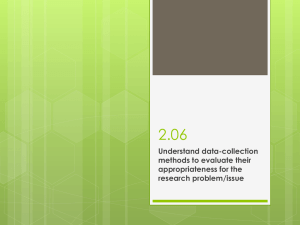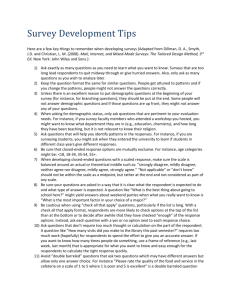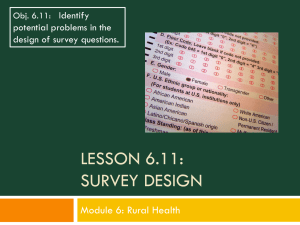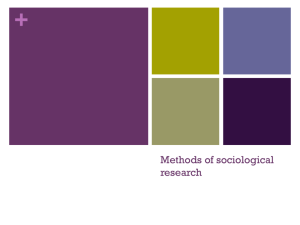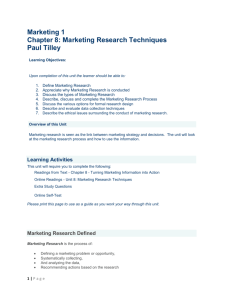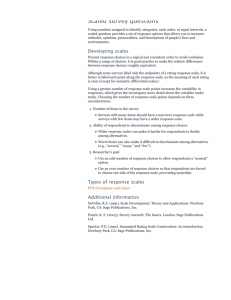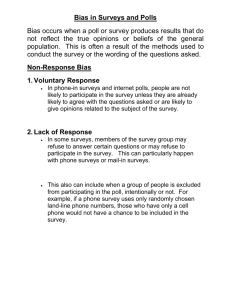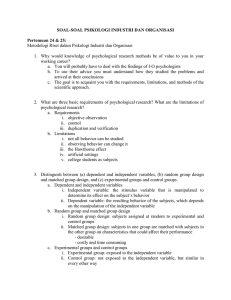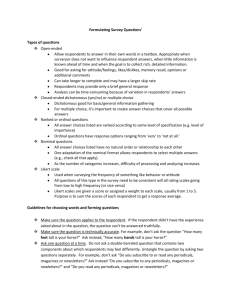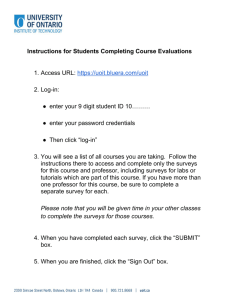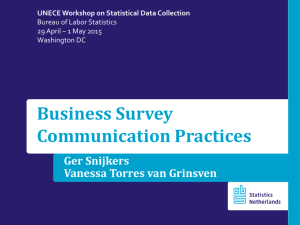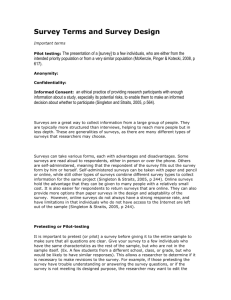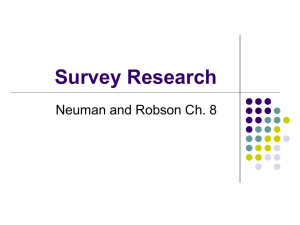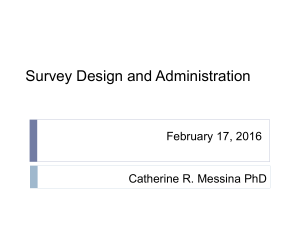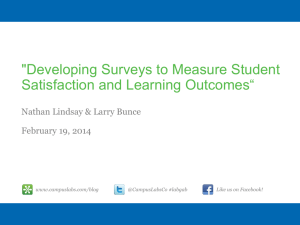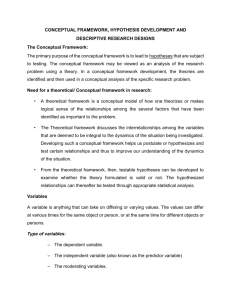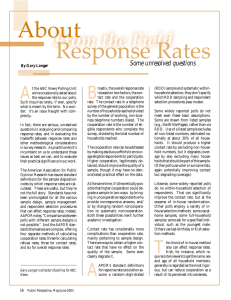Survey Terms and Survey Design
advertisement
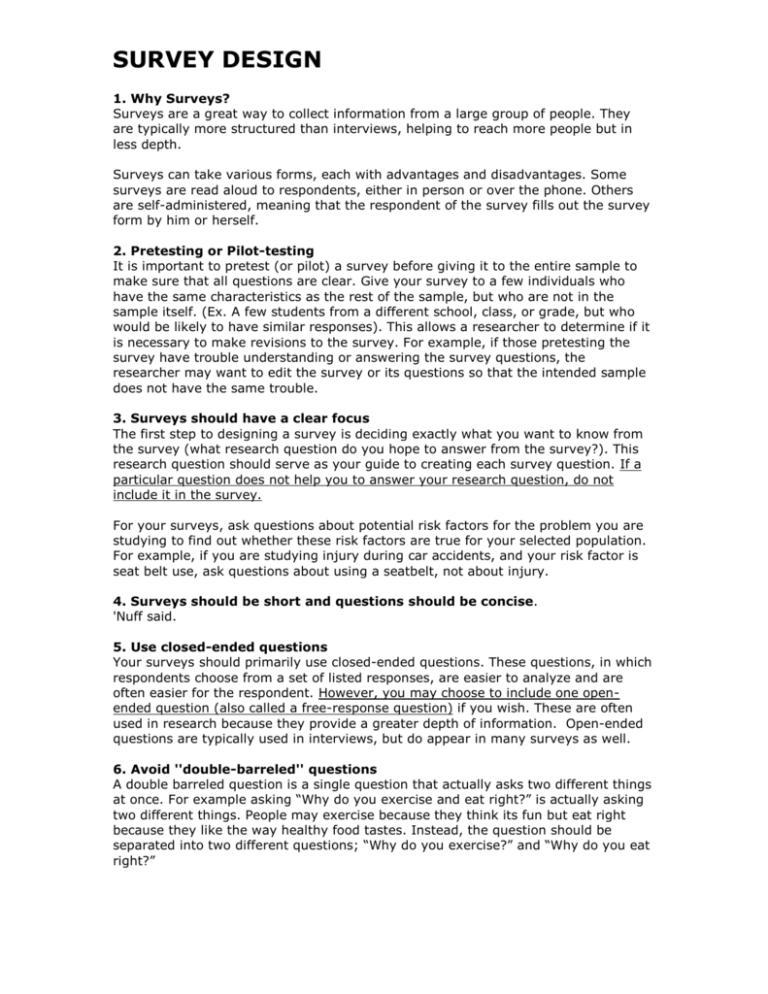
SURVEY DESIGN 1. Why Surveys? Surveys are a great way to collect information from a large group of people. They are typically more structured than interviews, helping to reach more people but in less depth. Surveys can take various forms, each with advantages and disadvantages. Some surveys are read aloud to respondents, either in person or over the phone. Others are self-administered, meaning that the respondent of the survey fills out the survey form by him or herself. 2. Pretesting or Pilot-testing It is important to pretest (or pilot) a survey before giving it to the entire sample to make sure that all questions are clear. Give your survey to a few individuals who have the same characteristics as the rest of the sample, but who are not in the sample itself. (Ex. A few students from a different school, class, or grade, but who would be likely to have similar responses). This allows a researcher to determine if it is necessary to make revisions to the survey. For example, if those pretesting the survey have trouble understanding or answering the survey questions, the researcher may want to edit the survey or its questions so that the intended sample does not have the same trouble. 3. Surveys should have a clear focus The first step to designing a survey is deciding exactly what you want to know from the survey (what research question do you hope to answer from the survey?). This research question should serve as your guide to creating each survey question. If a particular question does not help you to answer your research question, do not include it in the survey. For your surveys, ask questions about potential risk factors for the problem you are studying to find out whether these risk factors are true for your selected population. For example, if you are studying injury during car accidents, and your risk factor is seat belt use, ask questions about using a seatbelt, not about injury. 4. Surveys should be short and questions should be concise. 'Nuff said. 5. Use closed-ended questions Your surveys should primarily use closed-ended questions. These questions, in which respondents choose from a set of listed responses, are easier to analyze and are often easier for the respondent. However, you may choose to include one openended question (also called a free-response question) if you wish. These are often used in research because they provide a greater depth of information. Open-ended questions are typically used in interviews, but do appear in many surveys as well. 6. Avoid ''double-barreled'' questions A double barreled question is a single question that actually asks two different things at once. For example asking “Why do you exercise and eat right?” is actually asking two different things. People may exercise because they think its fun but eat right because they like the way healthy food tastes. Instead, the question should be separated into two different questions; “Why do you exercise?” and “Why do you eat right?” SURVEY DESIGN 7. Avoid ''leading questions'' A leading question suggests a possible answer or makes some responses seem better than others. In the example above, respondents are asked “Why do you exercise”? However, some respondents may not exercise at all. Which option would a person choose below if they never exercised? 1. Why do you exercise? (select all that apply) A. B. C. D. I exercise because it is fun I exercise to become healthy I exercise to stay healthy I exercise because I feel good afterward You could split this question into two separate questions. Alternatively, you can keep the questions combined as long as you include an “I do not exercise” response option. 2. If you exercise, what is the primary reason why you exercise? (select one) A. B. C. D. E. I exercise because it is fun I exercise to become healthy I exercise to stay healthy I exercise because I feel good afterward I do not exercise Another type of leading question makes the respondent think that they should answer a question in a particular way. In the following example, the use of the word “love” makes individuals think that they should love math class. Even the responses to this question are bias because love is used as an option. 3. How much do you love math class? A. I love math class more than most people B. I love math class the same as most people C. I love math class less than most people However, asking people how they feel about math class, instead of how much do they love math class, allows them to report their own feelings about the course. 4. Please rate your feelings about math class on the scale below: 1 I love it! 2 3 It's O.K. 4 5 I hate it! 8. Response Options Multiple choice (Respondents only select one option; see example #2) Choose from a list (Respondents may select several options; see example #1) Scale (Respondents choose a degree of agreement with a statement; see example #4)
